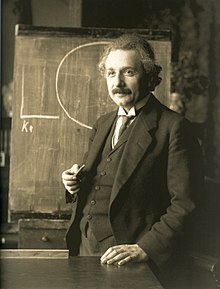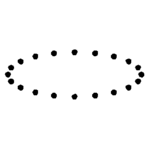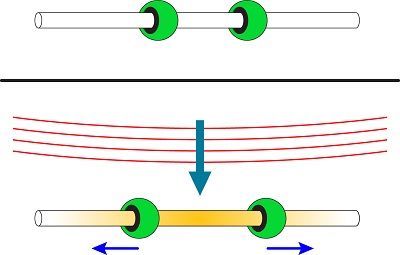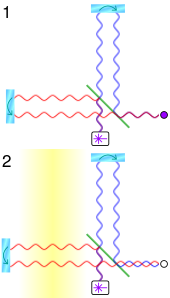Gravitational Waves
Introduction
Gravitational waves are ripples in the "fabric" of our space-time. This phenomenon was predicted by Albert Einstein's 1916 Theory of General Relativity, as a side-effect related to gravity being the distortion of space-time. These waves, only relatively recently, became directly observable using purpose built inferometers. The magnitude of an astronomical gravitational wave event is so very small, that it requires extreme precision and isolation to detect.[1]
This page seeks to introduce the reader to a (brief) history of gravitational waves, the anatomy of this phenomenon, observations, and implications of this phenomenon. I'm assuming a basic understanding of classical gravity/mass and some familiarity with modern physical concepts.
History
Any treatise on gravity or its phenomena without mentioning Isaac Newton’s contribution would be incomplete. Newton’s model of gravity has every particle attracting every other particle, and the force of the attraction being proportional to the square of the distance between the respective centers of mass. Universal gravitation proved to be astoundingly accurate for a lot of simple gravitational systems, and for a physical law created in 1687, this is profound. This simple model however did not give any indication about how the force propagated, just that is was a property of things with mass.
Theoretical physics had moved beyond work in gravitation. In the 1860’s – 1870’s James Clerk Maxwell, had introduced the application of mathematical field theory to electricity and magnetics, Electromagnetics. Why is this important? Maxwell had acknowledged the possibility gravitational fields. during this work. In “The Dynamical Theory of the Electromagnetic Field.” He postulated, “… we are naturally led to inquire whether the attraction of gravitation, which follows the same law of the distance, is not also traceable to the action of the surrounding medium.” Looking at Coulomb’s Law for electrical charges and its stark similarity to Newtonian gravitation, he was able to make the case for gravitational propagation. Maxwell does it again![1][2]
We are going to make a leap between Maxwell’s work to Einstein’s general relativity. Between these two events was a ton of pioneering work done by some physicist heavyweights. Although their hypotheses did not hold completely true they made very important contributions to the field, and definitely provided information and inspiration to the architect of general relativity. Oliver Heaviside published an article in 1893 titled, “A Gravitational and Electromagnetic Analogy,” and laid down a basis for traveling gravitational waves. This work was not completely correct without Einstein’s special relativity, but it did hint at a speed of light limit at which these waves could propagate. Henri Poincaré, in 1905, had proposed a relativistic model for gravity including Lorentz transformations for gravity, taking the Electromagnetic analogy one step further, just not quite landing a complete theory.[1][3]
In 1916, Albert Einstein published his paper on General Relativity, giving a clear theory of gravitational mechanisms. This paper did not introduce gravitational waves. This was a glaring omission that his peers were quick to inquire about. Gravitational waves proved to be a contentious subject for Einstein. He wrote replies and papers on the subject that ranged from strongly skeptical, to the outright denial of gravitational waves existence. It was not until much later, 1936, that a gravitational wave paper from Einstein and Rosen out of Princeton was published. This was taken up by the American physical community and both refuted and celebrated. The model arrived at looked like a quadrupole as it traveled transverse to the source, complete with proofs this time.[1][2][3]
A lot work has continued to be done as scientists dissect this phenomenon, trying to vet things like energy content of the waves, wave sources, and mathematical solutions related to geometry of our space time. Eventually leading up to very sophisticated attempts to experimentally arrive at their existence. This is by NO means a complete history! More of a 'why do we even bother' overview.
Gravitation and its Waviness
The mathematics of Gravitational Waves, although beautiful, are not so because of their simplicity. It was huge feat of theoretical physics to be able to take Einstein’s equations and apply a situation in such a way that waves become predicted. These equations are non-linear, and require some algebraic and geometrical concepts that is a bit beyond the scope of this. What we can talk about is the wave and its field, how it might look visually, and its quadrupole nature as mentioned in the history section.
What are these?
It’s a distortion in space-time… Space-time is our observable universe of 4-dimensions.[6] A disturbance in the backdrop would cause things to move in accordance to the shift in the wave. It is transverse wave, so as it moves, the poles of the force would cause these shifts, if we’re living in Cartesian land, on an X-Y plane, while the wave travels in the Z-direction. However, this movement isn’t along just one line. 4-primary poles of movement occur, hence our quadrupole![4] You can tell by the way that it is.
The formation of these waves happens any time there is mass that is accelerated. We just don’t see, feel, or notice these effects because these waves are so miniscule from most gravity events that they might as well not even exists. A gravitational event on the order of black holes merging has to occur for a disturbance on the order of a fraction of a Hydrogen atoms interior dimension.[2]
How does it look?
Have some pictures and some motion. They are just better at describing this than I ever could be.
Does it have energy ?
Feynman famously tied this abstract idea of ripples in space-time to a physical phenomenon called the “Sticky Bead Argument.” This wave imparts energy by causing motion of mass containing objects. It would make sense that a bead sliding on stick would cause friction. So, if changing gravity moves that bead, heat is generated! Voila, energy containing wave. Feynman is really good.[2]
Observations
We have two ways to observe physical things; indirect and direct. Direct is more preferable for establishing causality, especially when we’re talking about unproven phenomena! Direct measurement proved to more difficult, and thus indirect measurements were attempted first as physical science worked to refine definitions and methods.
For indirect measurements, what can we use to infer these ripples? What is distorted on top of space-time? It turns out EM radiation is our friend here because EM is distorted by gravity. The first attempt observations were of astronomical phenomena. Studying the motion of binary systems proves really useful, as the trajectory insinuates a loss in energy that has to be released somewhere. The work with the Hulse-Taylor binary system and its use in indirect measurement of gravitational waves netted the namesake team a Nobel Prize in 1993. Unfortunately, the predicted amplitude of waves from the system are too small to verify directly on Earth with current technology.[2][5]
Directly, we can also use EM waves to sense the shifts. We can do this in space or even on Earth. We can do this by sensing distance changes using inferometers. These sense the “stretch” as waves pass from changes in dimension. Then we can use arrays to build a clear picture of the wave as it passes. Use of arrays is also important because the noise from all the other disturbances things can experience.
The Laser Interferometer Gravitational-Wave Observatory (LIGO), in 2016, gave us the first directly observed gravitational wave, with extreme confidence. The observatory actually consists of two extremely large interferometers on opposing sides of the continental United States, and this is done to take advantage of array confirmation. There also other Earth-based observatories that exist and that are being planned/built, but the LIGO project has proven robust enough to provide repeated measurements of gravitational waves.[5]
Bibliography
-
Rothman, Tony. (2018, March). The Secret History of Gravitational Waves. American Scientist, 106 (2). Retrieved from: https://www.americanscientist.org/article/the-secret-history-of-gravitational-waves
-
Kennefick, D. 2016. History of Gravitational Wave Emission. Presentation, in conjunction with the Einstein Papers Project, at the 6th Francis Bacon Conference. Retrieved from: http://burkeinstitute.caltech.edu/documents/12-kennefick.pdf
-
Cervantes-Cota, Jorge & Galindo, Salvador & Smoot, George. (2016). A Brief History of Gravitational Waves. Universe. 2. 22. 10.3390/universe2030022. Retrieved from: https://www.researchgate.net/publication/308231633_A_Brief_History_of_Gravitational_Waves
-
Schutz, B.F. (2011, September) Gravitational Waves Notes for Lectures at the Azores School on Observational Cosmology: Lecture 1- Elementary Theory of Gravitational Wave and their Detection. [Notes] Retrieved from: https://www.aei.mpg.de/~schutz/download/lectures/AzoresCosmology/Schutz.AzoresLecture1.pdf
-
(2019) LIGO: Laser Interferometer Gravitational-Wave Observatory. Retrieved from: https://www.ligo.caltech.edu/page/ligo-detectors
-
Greshko, M. (2019, March 26). What are gravitational waves? [Blog post] National Geographic. Retrieved from: https://www.nationalgeographic.com/science/space/reference/gravitational-waves/
Media
-
Watterson, Bill. "Calvin on General Relativity." Calvin and Hobbes. 26 Nov. 2019. https://thefinchandpea.com/2010/09/20/calvin-on-general-relativity/
-
Schmutzer, F. (1921) Albert Einstein during Vienna Lecture in 1921. [jpeg] Retrieved from: https://upload.wikimedia.org/wikipedia/commons/3/3e/Einstein_1921_by_F_Schmutzer_-_restoration.jpg
-
Aulicino, B. (2018, March) The Family of Waves. American Scientist. 106 (2). Retrieved from: https://www.americanscientist.org/article/the-secret-history-of-gravitational-waves
-
(2006). An animation of the effect of a (plus-polarized) gravitational wave on a ring of test particles. [gif] Gravitational Waves: Wikipedia. Retrieved from: https://en.wikipedia.org/wiki/Gravitational_wave#/media/File:GravitationalWave_PlusPolarization.gif
-
(2016). A picture of two swirling black holes distorting gravity. [jpg] Scientists make first direct detection of gravitational waves. MIT News. Retrieved from: http://news.mit.edu/2016/ligo-first-detection-gravitational-waves-0211
-
(2016). Video simulation of the changing gravitational field, and gravitational waves, during the final inspiral, merger and ringdown of GW150914. [webm] Retrieved from: https://en.wikipedia.org/wiki/File:Warped_Space_and_Time_Around_Colliding_Black_Holes_(Courtesy_Caltech-MIT-LIGO_Laboratory,_produced_by_SXS_project).webm
-
(2015) Sticky Bead Argument Diagram [jpg]. Write Science, Blog. Retrieved from: https://writescience.wordpress.com/2015/04/24/gravity-11-ripples-in-spacetime/
-
Simplified operation of a gravitational wave observatory. [png] Retrieved from:https://commons.wikimedia.org/wiki/File:Gravitational_wave_observatory_principle.svg
-
Dual detectors with arrows and stns labeled. [jpg] LIGO’s dual detectors. Retrieved from: https://www.ligo.caltech.edu/page/ligo-detectors







